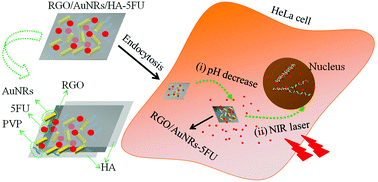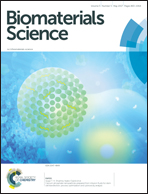RGO/AuNR/HA-5FU nanocomposite with multi-stage release behavior and efficient antitumor activity for synergistic therapy
Abstract
A reduced graphene oxide (RGO)/gold nanorod (AuNR)/hydroxyapatite (HA) nanocomposite was designed and successfully synthesized for the first time. An anticancer drug, 5-fluorouracil (5FU), was chosen as a model drug to be loaded in RGO/AuNR/HA. The fabricated RGO/AuNR/HA-5FU showed robust, selective targeting and penetrating efficiency against HeLa cells due to the good compatibility and nontoxicity of HA, and showed excellent synergetic antitumor effects through combined chemotherapy (CT) by 5FU and photothermal therapy (PTT) by both RGO and AuNRs under near-infrared (NIR) laser irradiation. More importantly, this synergistic dual therapy based on RGO/AuNR/HA can also minimize side effects in normal cells and exhibits greater antitumor activity because of a multi-stage drug release ability triggered by the pH sensitivity of HA in the first stage and the combined photothermal conversion capabilities of RGO and AuNRs by means of the NIR laser irradiation in the second stage. This study suggests that the novel RGO/AuNR/HA multi-stage drug delivery system may represent a promising potential application of multifunctional composite materials in the biomedical field.



 Please wait while we load your content...
Please wait while we load your content...